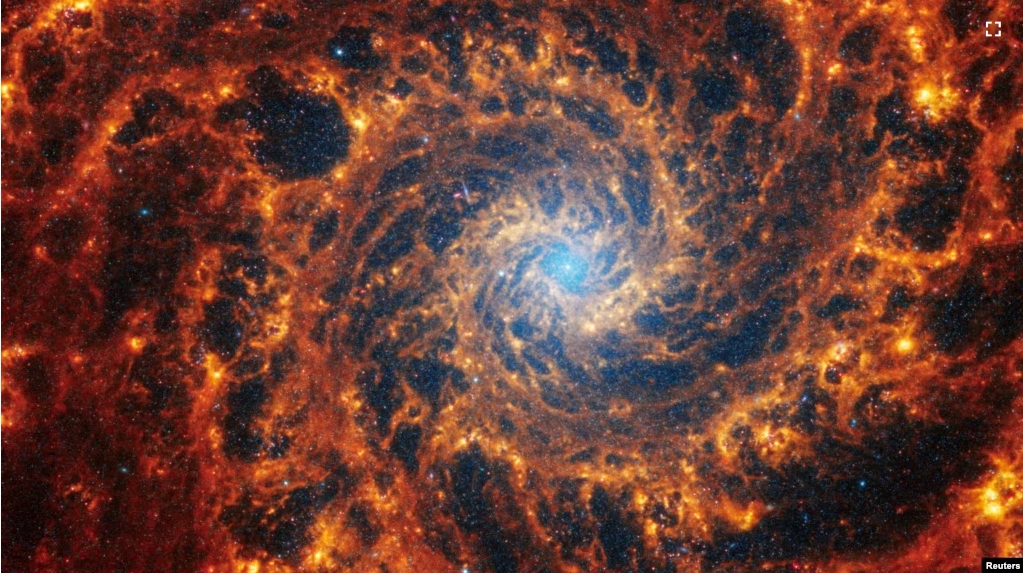Data collected by the James Webb Space Telescope has confirmed earlier information suggesting the universe is expanding at a faster rate than scientists had expected.
The new finding is based on measurements collected by the Webb over the past two years. The telescope is operated by the American space agency NASA.
Researchers say the new readings show that our universe is growing faster today than it did in the period after it first formed billions of years ago. The data suggests the distances between nearby stars and galaxies are increasing. This confirms earlier studies based on data collected by other telescopes.
The finding that today’s universe is expanding faster than expected was first made in the 1990s by data gathered by NASA’s Hubble Space Telescope. In 1998, data examinations led a group of scientists to first conclude that our universe is expanding at an ever-increasing rate.
That finding was based on studies of huge explosive events called supernovas. NASA describes a supernova as an “extremely bright, super-powerful explosion of a star.” A supernova takes place at the end of a star’s life.
The 1990s research on supernovas and the universe’s continued expansion resulted in three scientists winning the 2011 Nobel Prize in Physics. One of the winners – Adam Riess of Johns Hopkins University in Maryland – was the lead writer of a study on the new data collected by the Webb telescope.
The study notes the idea of the universe expanding at an unexpected rate – and the mysterious reasons behind the growth – has long been known as Hubble Tension. The Nobel winners were awarded the prize in part for showing evidence that Hubble Tension may be caused by forces they describe as “dark energy.”
NASA says astronomers believe dark energy makes up about 68 percent of the universe, while dark matter makes up around 27 percent. But beyond that, very little is known about these two “dark” elements.
Riess – a professor of physics and astronomy – wrote about the new data produced by the Webb telescope observations. He said in a statement, “The discrepancy between the observed expansion rate of the universe and the predictions of the standard model suggests that our understanding of the universe may be incomplete.”
Riess noted that data from both the Webb and Hubble instruments had confirmed the earlier findings linked to the Hubble Tension problem. He said the ongoing mysteries of how dark energy might affect faster universe expansion presents a major “challenge” for scientists. However, the new data also provides new possibilities “to learn more about our universe.”
The researchers used three different methods to measure a specific value – the distances from Earth to galaxies where a kind of pulsating star called a Cepheid had been identified.
The universe’s expansion rate is measured in kilometers per second as megaparsecs, a distance equal to 3.26 million light-years. A light-year is the distance light travels in a year, about 9.5 trillion kilometers.
The researchers said the Webb’s observations appear to rule out the idea that the earlier Hubble data might have returned false information because of possible instrument errors. The team’s findings recently appeared in a study in the publication The Astrophysical Journal.
Siyang Li is a doctoral student in astronomy at Johns Hopkins who was a co-writer of the study. He told Reuters news agency the Webb results could mean “there may be a need to revise our model of the universe.” However, Li added that such a revision would be very difficult to make currently with existing data.
Li also noted a great improvement in the Webb data compared to the older Hubble information. “The Webb data is like looking at the universe in high-definition for the first time and really improves the signal-to-noise of the measurements,” he said.
The researchers suggested more work is needed to possibly unlock the Hubble Tension mystery. Riess said more data observations will be necessary to learn about what forces are continuing to drive expansion of the universe. And the team will next try to capture more detailed data on the rate of expansion, as well as seek to establish timelines for the growth.
I’m Bryan Lynn.
Bryan Lynn wrote this story for VOA Learning English, based on reports from Reuters, NASA and Johns Hopkins University.
_____________________________________________
Words in This Story
discrepancy – n. a difference between two things that should be the same
challenge – n. something difficult that tests one’s ability or determination
pulsate – v. to beat or move with a strong, regular rhythm
revise – v. to change something so that it is more correct
high-definition – adj. a system for showing very clear pictures on a television or computer screen
